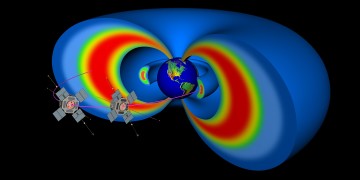on the Web
on Twitter
on YouTube
on FaceBook

| Full 57 seconds: |
| Brief 17 seconds: |
|
These signals are electromagnetic ion cyclotron waves, or EMIC waves, recorded by the Van Allen Probes A EMFISIS fluxgate magnetometer on 23 February 2014. Measurements of the BY component of the magnetic field in solar-magnetic (SM) coordinates, which is perpendicular to the Earth's dipole magnetic field axis and the Earth-Sun line, were used to make the audio tracks and animations. The two animations above present a frequency-time spectrogram for the BY SM component of the magnetic field that slides from right to left along the horizontal axis to indicate advancing time. The red arrows indicate the features in the spectrogram currently being heard in the audio track. Frequency ranges from low to high frequencies along the vertical axis, and the amplitude of the signals is color coded with blue indicating weak signals and red indicating strong signals. Unlike chorus waves, which have frequencies within the range of human hearing, EMIC waves occur at frequencies far below what we can hear. In order to create the two audio tracks presented here, time was compressed by a factor of about 300 to convert the EMIC waves into the frequency range we can hear. Thus, the longer audio recording lasts only 57 seconds even though it represents 4 hours and 45 minutes of data from 03:30 to 08:15 UTC, and the shorter audio recording from 06:45 to 08:10 UTC lasts only 17 seconds even though it represents 1 hour and 25 minutes of data. The frequencies of EMIC waves are determined by the the frequencies at which hydrogen (protons), helium, and oxygen ions trapped in Earth's magnetic field gyrate around the magnetic field lines. EMIC waves generated in the proton frequency band are shown here. Because Earth's magnetic field strength decreases with distance, as the spacecraft travels away from Earth and then back again along its orbit, the frequency of the proton band EMIC waves first decreases and then increases. This variation in frequency along the spacecraft orbit can be heard in the audio recording and animation from 03:30 to 08:15 UTC. In addition to the slow variation in frequency with distance from the Earth, the hydrogen band EMIC waves shown here have rising tones which increase rapidly in frequency over very short time intervals, and create the chirp-like sounds in the audio recordings. EMIC wave rising tones are similar to chorus rising tones that sound like chirping birds, but are generated by non-linear processes involving protons instead of electrons. The shorter 17 second animation from 06:45 to 08:10 UTC highlights an especially interesting interval of EMIC wave rising tones so that their chirp-like nature can be seen in better detail. While chorus waves can accelerate electrons trapped in the Van Allen radiation belts to dangerous velocities, EMIC waves can rapidly scatter the highest energy electrons into Earth's upper atmosphere, and contribute to radiation belt "electron flux drop-outs." The above was presented at the 2018 AGU Fall Meeting as |
|
on the Web |
on Twitter |
on YouTube |
on FaceBook |
| Last modified
Wednesday, 05-Dec-2018 12:28:25 CST © The University of Iowa 2006 - 2018. All rights reserved. Contact information. Send questions or comments to Craig Kletzing. Van Allen Probes EMFISIS, Department of Physics & Astronomy, College of Liberal Arts & Sciences. |
|